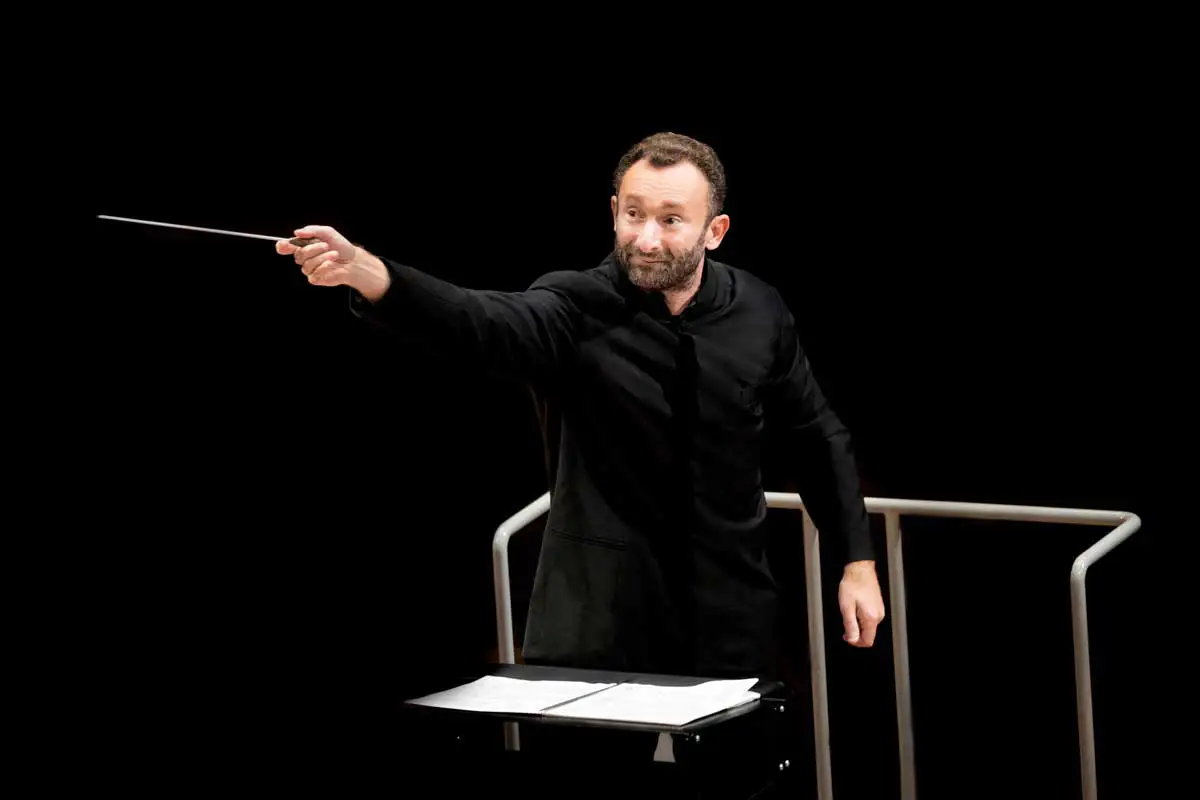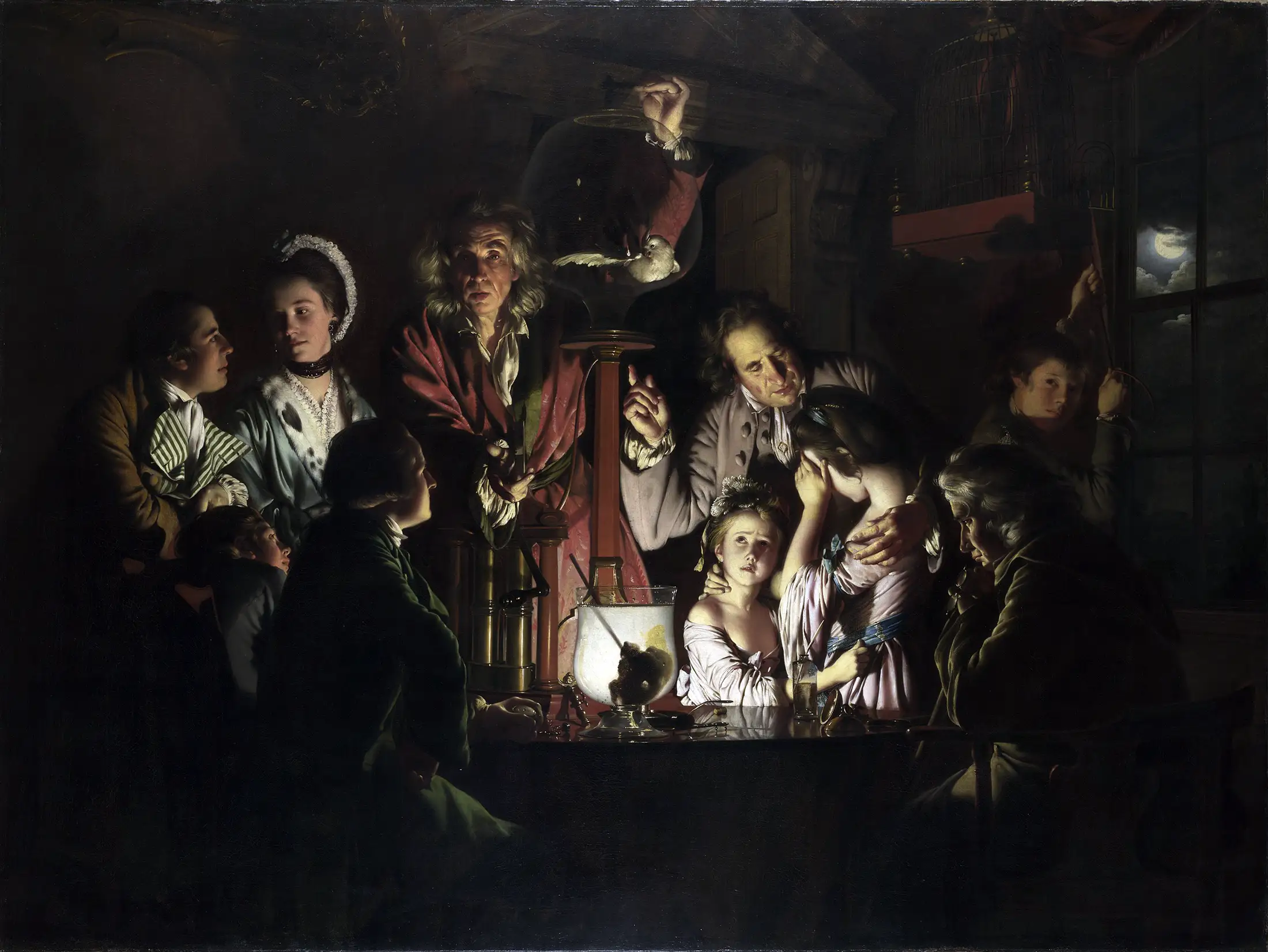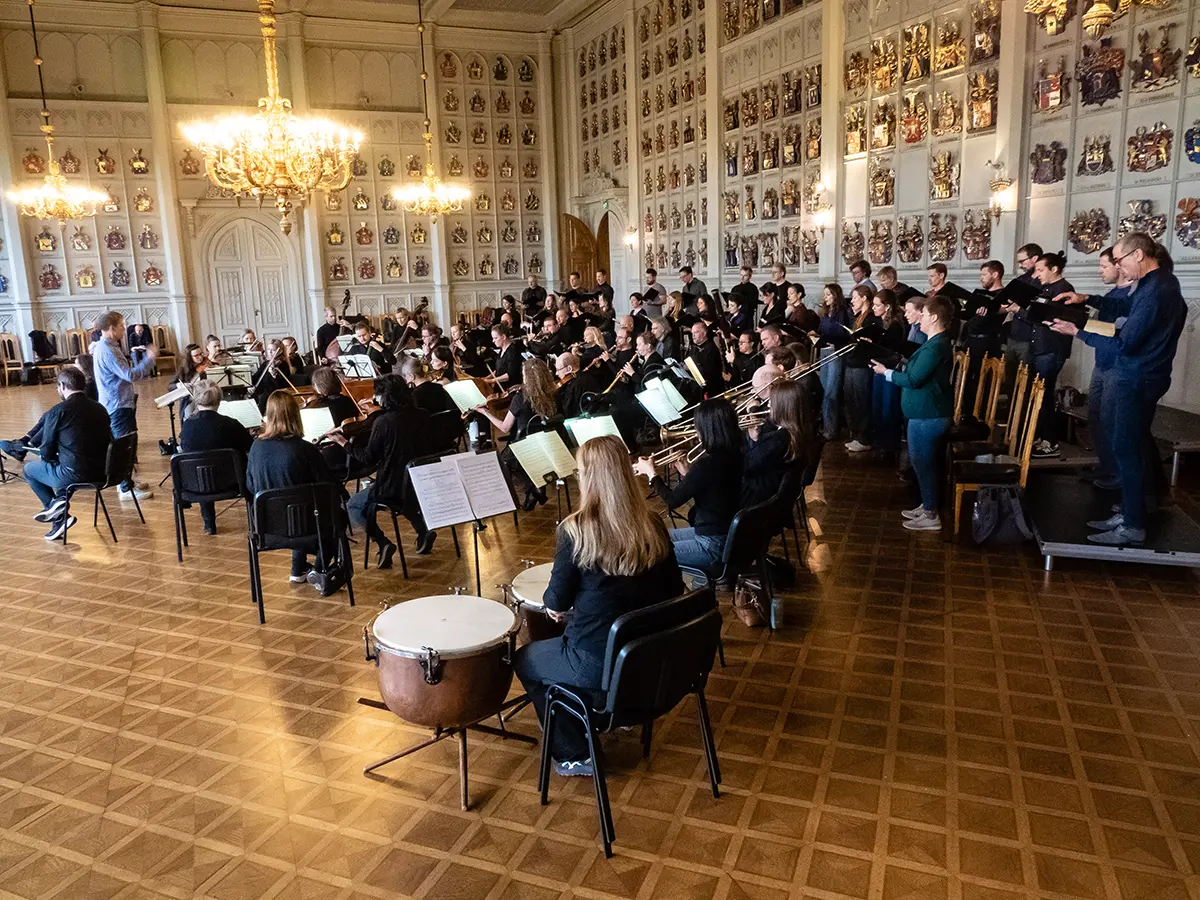
Berliner Philharmoniker recordings · Kirill Petrenko · Arnold Schoenberg 3 CD / 1 Blu-ray Disc
The Berlin Philharmoniker, under the direction of Chief Conductor Kirill Petrenko, presents a box set of live recordings featuring some of Schönberg’s most ‘beloved’ works, including Verklärte Nacht and Chamber Symphony No.1. The true highlight of this superb collection, however, is the rarely performed oratorio Die Jakobsleiter.
The Russian-Austrian conductor Kirill Petrenko has long championed Arnold Schönberg’s orchestral and vocal works. Simon Rattle, Petrenko’s predecessor as chief conductor of the Berlin Philharmonic (BP), didn’t shy away from programming Schönberg either, but for Petrenko the Austrian–American composer has held a special significance since his student days. Since taking up the post in 2019, he has led several Schönberg performances with the orchestra, now collected in a boxed set with three CDs, a Blu-ray disc and an extensive booklet. A few of these will undoubtedly rank among the very finest – unsurprising , given the Berlin Phil’s deep familiarity with this repertoire.
Verklärte Nacht (Transfigured Night), originally conceived in 1899 as a sextet, was arranged by Schönberg in 1917 for string orchestra. When two decades later an American publisher showed interest in publihing the work, Schönberg added a double bass, gave it more structure and dynamics, and inserted tempo markings. This version (1943), more suited to large concert halls, has since become his most frequently performed and recorded work.
Verklärte Nacht is a programmatic chamber symphony inspired by Richard Dehmel’s poem, which, if we are to believe the poet, explores – like most of his works – ¨love and sex¨ (to put it crudely).
The work opens in D-minor with descending viola and cello lines, painting the cold, moonlit grove through which a downcast woman and a man march, very slowly . In a ¨dramatic outburst¨ the woman confesses that she is pregnant with the child by another man she does not love, deeply regretting the meaningless, brief affair. Her new lover responds that the child will not burden him, he will accept it as his. He can feel a warmth that ¨will transfigure the other’s child; you will bear it for me… you have brought radiance on me.¨
The emotional journey is explored through ever shifting tonalities – D minor, B-flat minor, C minor, E-major – finally resolving in joyous D-major. There is free atonality, chromaticism, but no sign yet of the the 12-tone system that Schönberg was to develop later.
In the first movement the Berlin Philharmonic paints a clear picture of the moonlit landscape and the anguish of the young woman. The buildup to her confession and the pregnant pause (excuse the pun) in anticipation of the boyfriend’s reaction, holds all the depth, tension and subsequent release that one could wish for. Petrenko is not tempted to speed up through the sequence of mood swings, honoring instructions like Molto Rallentando (slow down a lot) and Pesante (weighty). The Adagio unfolds with a lush, late-romantic Straussian warmth executed to perfection by the Berlin Philharmonic’s famously radiant strings. Once the transfiguration has taken place, there’s a brief moment of erotic passion ( Dehmel had sex on his brain) as the couple embrace (Tr 5 1’23¨), before they head off ‘molto tranquillo’ into the clear night and the grove with its tall trees.
At 27’36 Petrenko’s interpretation is considerably swifter than some classic accounts – notably Karajan’s much heralded 1973 Berlin recording– but never feels hurried.

Tackling Schönberg’s Violin Concerto is notoriously daunting – the great Jascha Heifetz, offered the premiere in 1940, after a few rehearsals gave up. Even today, it remains a rarity in violinists’ repertoire. The density and complexity of the writing for the violin can easily appear at odds with the orchestral accompaniment, if the forward momentum is lacking. If Schönberg set out to compose a work rigidly based on the 12-tone row (using notes 1-2-7-8 of the row), he failed. There are many tonal and thematic characteristics that make the atonal, angular and rather noisy passages very approachable for most open-minded listeners.
Patricia Kopatchinskaja’s idiosyncratic virtuosity is well-suited to the concerto. She has Schönberg’s melodrama Pierrot Lunaire in her repertoire, simultaneously playing the violin while acting and delivering the Sprechgesang part. In the concerto, her approach is at times brash and combative—understandably so, as one must truly project over the orchestra in certain passages. And yet she fails to pull my heartstrings, perhaps because the doesn’t quite expose the tenderness present in the Andante grazioso. Compared with Hilary Hahn’s (studio) recording with Esa-Pekka Salonen and the Swedish Radio Symphony Orchestra, the difference is very noticeable. Hahn embraces the romantic glow (with a passion), while making light of the technical demands, and still finishes four minutes faster than Kopatchinskaja. Hahn has made a point of religiously observing Schönberg’s tempo markings, and yet somehow makes the concerto feel less opaque and challenging. Schönberg’s violin concerto demands a supremely reliable conductor. Petrenko rises to the challenge, but Salonen remains just a touch sharper.

The real pearl of this boxed set collection has to be the seldom heard oratorio Die Jakobsleiter. The work requires nine soloists, a large choir, and full orchestra, as well as four smaller ensembles ideally placed high in the auditorium.
Die Jakobsleiter (Jacob’s Ladder) refers to the story in Genesis in which Jacob – fleeing from his brother Esau – dreams of a ladder reaching from earth to heaven, with angels ascending and descending upon it. Schönberg doesn’t stick to the Biblical tale, but its significance remains the same: it becomes a parable about humanity’s struggle with faith. The ladder symbolises the soul’s path toward divine enlightenment. It is a metaphor for spiritual progression. It also reflects Schönberg’s lifelong preoccupation: he converted from Judaism to Protestantism and in 1933, following the power grab by the Nazis, he returned to Judaism. He was also deeply engaged with theosophy and mysticism, which also influenced the oratorio’s text.
In 1911 Schönberg began planning a symphony on the scale of Mahler’s 8th, and Jacob’s vision was intended as its culminating movement. He initially considered adapting Strindberg’s Jacob Wrestling and Honoré de Balzac’s Séraphite for the libretto, but ultimately compiled the text himself. Abandoning the idea of a multi-movement symphony, he turned instead to composing an oratorio, making numerous sketches until he was called up for military service in 1914. Though discharged for health reasons, the interruption stifled his creativity, and he didn’t resume the project until 1917. By 1922 much of the work on the choral and orchestral scoring had been completed, and four years later the work had largely taken shape. After emigrating with his family to Los Angeles in 1933, Schönberg found himself preoccupied with other concerns. But the fact that he after the war on several occasions attempted to finish the oratorio underscores the importance of the work to him.
At the request of Schönberg’s widow Gertrud, his former pupil Winfried Zillig put together a performance score based on the many fragments and autograph sources. Die Jakobsleiter was premiered in June 1961 at the Vienna Konzerthaus, conducted by Rafael Kubelik with the Kölner Rundfunk-Sinfonie-Orchester.
All types of people – One who is rebellious, The monk, The quietly resigned, One who is struggling, and many others who – like Jacob – wrestle with their guilty conscience are on their way up the ladder in search of reunion with the Lord. The Archangel Gabriel urges them to bare their souls, but admonishes them when they are found wanting. The Chosen One, who has Gabriel’s blessing, is meant to offer some counsel, but fears that his words may be misunderstood. A Dying Person comes to the realisation that she has endured a thousand deaths. Gabriel guides her soul upward on the ladder, toward reincarnation and ultimate union with God.
Musically Die Jakobsleiter looks ahead to the works in which Schönberg would adopt his stricter twelve-tone method. At the opening of the oratorio, two six-tone rows – first in the cellos, then in the brass – foreshadow his later serial works. The entire composition is constructed, both vertically and horizontally, from variations on these recurring twelve pitches. From the start the Berlin Phil are setting out their stall in these opening six-tone rows, with a fervent conviction that Luther would have been proud of. (For Luther the ladder was a testament to God’s initiative in bridging heaven and earth, with the coming of Christ being the ultimate fulfillment of the vision).
The large choir fulfills the role of a classic Greek chorus, but is also subdivided into groups such as Malcontents, Doubters, Rejoicers. Toward the end of the oratorio, a small number of female voices, positioned on different levels in the auditorium, exhorts the souls to ¨efface the senses …. melt away¨. The Rundfunkchor Berlin delivers this eerie, fiendishly difficult music with remarkable ease, guided with brilliance by their Principal Conductor Gijs Leenars.
Sprechegsang is the performance practice employed here, yet it follows no strict rules, which makes every interpretation of a ‘speak-singing’ role highly individual. The strong cast assembled by Petrenko are in their element, delivering performances that are consistently powerful, and at times even commanding. Among them, the promising Hungarian baritone Gyula Orendt stands out: his portrayal of the Chosen One encapsulates the air of desperation and deep self-doubt that permeates this work. Bass-baritone Wolfgang Koch – best known for his Wagner interpretations – embodies a merciful Archangel Gabriel, serving as God’s mediator. His deep voice carries a naturally authorative resonance. Finally, the promise of heaven – no longer expressed in words – is conveyed by Liv Redpath (The Soul) whose crystal-clear soprano leggero brings the oratorio to a serene and radiant close.
Under Kirill Petrenko’s direction, the whole ensemble achieves a remarkable clarity and balance, bringing out the oratorio’s dramatic qualities in a way that would lend itself beautifully to a fully staged concert performance.
The box also includes the Chamber Symphony No.1, which Schönberg described a ‘turning point’ in his artistic development. Here, he pushes the boundaries, while still holding on to the lifeline of tonality. The work is laced with shreds of romanticism in the spirit of Brahms, Mahler and Richard Strauss, yet its restless bustle – driven by superimposed fourths and whole-tone scales – ensures that you’re never entirely at ease. With the Berlin Philharmonic’s 15 virtuosic soloists at the helm, the piece keeps you on the edge of your seat for its full 20 -minute span.
Variations for Orchestra op. 31 is the only work by Schönberg to have been premiered (in 1928) by the Berlin Philharmonic. It is also the first orchestral work to employ the twelve-tone row in all its myriad transformations. The Arnold Schönberg Center in Vienna explains: ¨To shape the theme of the variation Schönberg uses four forms of rows which are related via hexachordal inversional combinatoriality.¨ I’m not quite sure what that means, but it’s clearly fiendishly complicated, and quite honestly, beyond me. Leonard Bernstein hailed Variations as a masterpiece, and if he says so, it must be true. But I can hear the Berlin Philharmonic, under their outstanding conductor, is tackling this ‘further maths’ of music with gusto, and quite possibly as well, if not better than, any orchestra in the world. I’ll leave it to you to be the judge.
This box set set with aforementioned works by Schönberg, or if you prefer Schoenberg, is out now (September 2025). The blu-ray disc contains visual recordings of all the works contained on the CDs – very useful indeed, particularly for comprehending what’s going on in Die Jakobsleiter.



